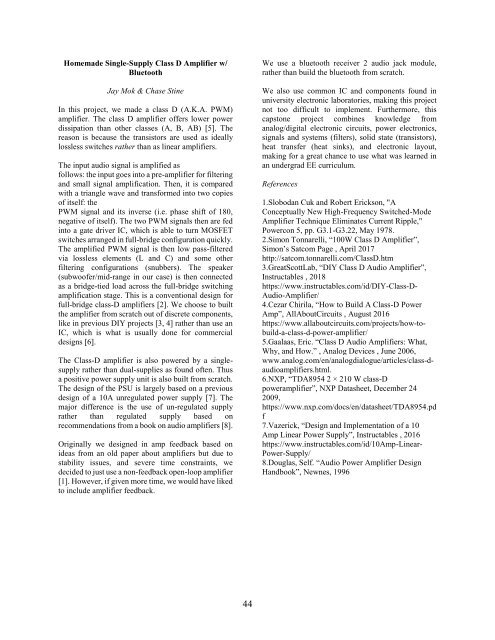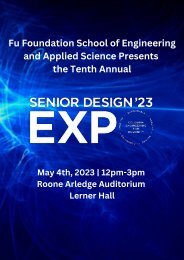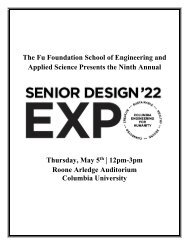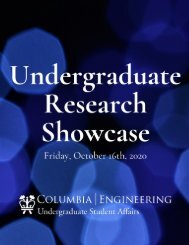Senior Design Expo 2019
The Senior Design Expo, held annually in May at Columbia University, is an opportunity for Columbia Engineering students to showcase what they have learned in their foundational math and science courses together with their engineering courses in innovative, creative, and purposeful designs and prototypes. Each year the Expo showcases more than 60 projects across all nine departments. Projects have included cutting-edge robotics, the New York City subway system, language technology, proposals for bridges to span the Hudson river, and much more.
The Senior Design Expo, held annually in May at Columbia University, is an opportunity for Columbia Engineering students to showcase what they have learned in their foundational math and science courses together with their engineering courses in innovative, creative, and purposeful designs and prototypes. Each year the Expo showcases more than 60 projects across all nine departments. Projects have included cutting-edge robotics, the New York City subway system, language technology, proposals for bridges to span the Hudson river, and much more.
Create successful ePaper yourself
Turn your PDF publications into a flip-book with our unique Google optimized e-Paper software.
Homemade Single-Supply Class D Amplifier w/<br />
Bluetooth<br />
Jay Mok & Chase Stine<br />
In this project, we made a class D (A.K.A. PWM)<br />
amplifier. The class D amplifier offers lower power<br />
dissipation than other classes (A, B, AB) [5]. The<br />
reason is because the transistors are used as ideally<br />
lossless switches rather than as linear amplifiers.<br />
The input audio signal is amplified as<br />
follows: the input goes into a pre-amplifier for filtering<br />
and small signal amplification. Then, it is compared<br />
with a triangle wave and transformed into two copies<br />
of itself: the<br />
PWM signal and its inverse (i.e. phase shift of 180,<br />
negative of itself). The two PWM signals then are fed<br />
into a gate driver IC, which is able to turn MOSFET<br />
switches arranged in full-bridge configuration quickly.<br />
The amplified PWM signal is then low pass-filtered<br />
via lossless elements (L and C) and some other<br />
filtering configurations (snubbers). The speaker<br />
(subwoofer/midrange in our case) is then connected<br />
as a bridge-tied load across the full-bridge switching<br />
amplification stage. This is a conventional design for<br />
full-bridge class-D amplifiers [2]. We choose to built<br />
the amplifier from scratch out of discrete components,<br />
like in previous DIY projects [3, 4] rather than use an<br />
IC, which is what is usually done for commercial<br />
designs [6].<br />
The Class-D amplifier is also powered by a singlesupply<br />
rather than dual-supplies as found often. Thus<br />
a positive power supply unit is also built from scratch.<br />
The design of the PSU is largely based on a previous<br />
design of a 10A unregulated power supply [7]. The<br />
major difference is the use of un-regulated supply<br />
rather than regulated supply based on<br />
recommendations from a book on audio amplifiers [8].<br />
Originally we designed in amp feedback based on<br />
ideas from an old paper about amplifiers but due to<br />
stability issues, and severe time constraints, we<br />
decided to just use a non-feedback open-loop amplifier<br />
[1]. However, if given more time, we would have liked<br />
to include amplifier feedback.<br />
We use a bluetooth receiver 2 audio jack module,<br />
rather than build the bluetooth from scratch.<br />
We also use common IC and components found in<br />
university electronic laboratories, making this project<br />
not too difficult to implement. Furthermore, this<br />
capstone project combines knowledge from<br />
analog/digital electronic circuits, power electronics,<br />
signals and systems (filters), solid state (transistors),<br />
heat transfer (heat sinks), and electronic layout,<br />
making for a great chance to use what was learned in<br />
an undergrad EE curriculum.<br />
References<br />
1.Slobodan Cuk and Robert Erickson, "A<br />
Conceptually New High-Frequency Switched-Mode<br />
Amplifier Technique Eliminates Current Ripple,"<br />
Powercon 5, pp. G3.1-G3.22, May 1978.<br />
2.Simon Tonnarelli, “100W Class D Amplifier”,<br />
Simon’s Satcom Page , April 2017<br />
http://satcom.tonnarelli.com/ClassD.htm<br />
3.GreatScottLab, “DIY Class D Audio Amplifier”,<br />
Instructables , 2018<br />
https://www.instructables.com/id/DIY-Class-D-<br />
Audio-Amplifier/<br />
4.Cezar Chirila, “How to Build A Class-D Power<br />
Amp”, AllAboutCircuits , August 2016<br />
https://www.allaboutcircuits.com/projects/how-tobuild-a-class-d-power-amplifier/<br />
5.Gaalaas, Eric. “Class D Audio Amplifiers: What,<br />
Why, and How.” , Analog Devices , June 2006,<br />
www.analog.com/en/analogdialogue/articles/class-daudioamplifiers.html.<br />
6.NXP, “TDA8954 2 × 210 W class-D<br />
poweramplifier”, NXP Datasheet, December 24<br />
2009,<br />
https://www.nxp.com/docs/en/datasheet/TDA8954.pd<br />
f<br />
7.Vazerick, “<strong>Design</strong> and Implementation of a 10<br />
Amp Linear Power Supply”, Instructables , 2016<br />
https://www.instructables.com/id/10Amp-Linear-<br />
Power-Supply/<br />
8.Douglas, Self. “Audio Power Amplifier <strong>Design</strong><br />
Handbook”, Newnes, 1996<br />
44








